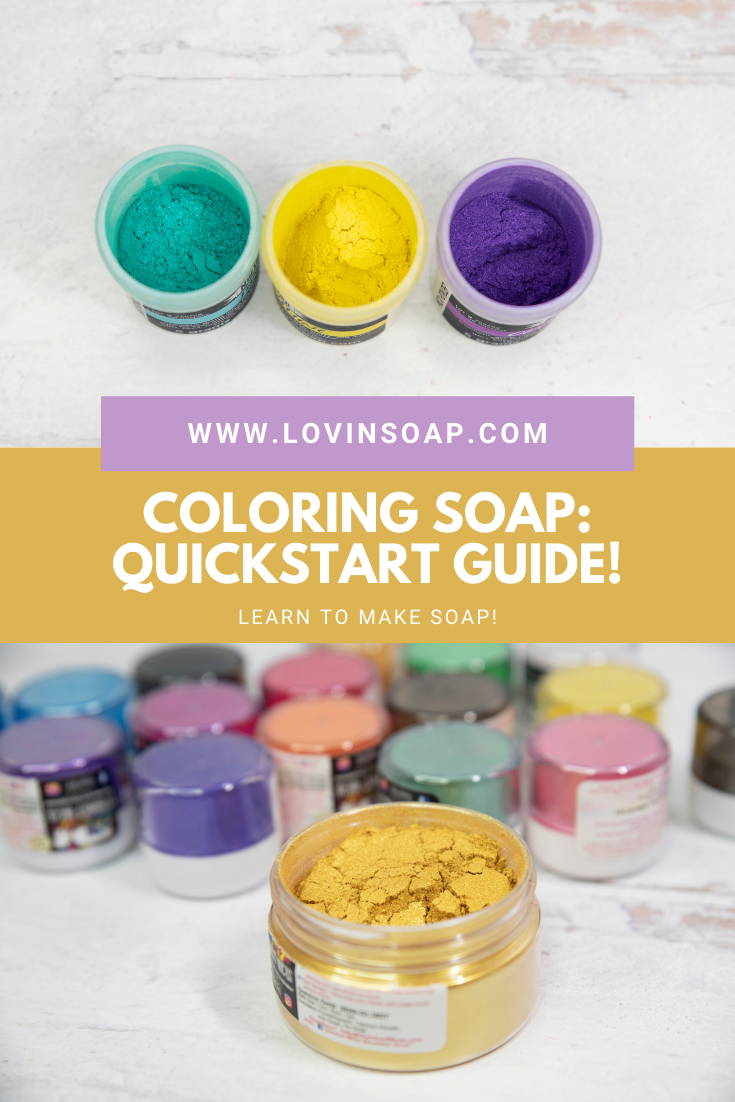When you first start making cold process soap, color choices can be really overwhelming! I wanted to create this guide to help break down the colorants for cold process soap and help you learn how to use them.
If you are just getting started in coloring and swirling your soap, I highly recommend our Secrets of Swirling Cold Process Soap eCourse!
Mica
You can find a rainbow of colors when it comes to mica. You can also blend your own colors to make even more options. Mica is natural and is mined from the earth. It is naturally off-white in color with tan to gray tones. There is also a synthetic version of mica called fluorphlogopite. This synthetic mica is made in a lab.
Most suppliers to the soap and cosmetic industry sell mica colorants containing natural mica. It is a misconception that most suppliers sell synthetic mica. They don’t. Some suppliers have a handful of synthetic option, but the majority are natural.
Synthetic mica is preferred by some product manufacturers over naturally mined mica because it is purer, can produce more bold colors and has smoother edges, reducing tearing and damage to the skin. There can also be human-rights issues surrounding the mining of natural mica, which can be avoided by using synthetic.
The micas that we purchase from suppliers are not 100% mica. To get their vibrant colors, mica is colored using either dye (FD&C/D&C dyes) or mineral pigments (oxides/ultramarines). How do you know what is in your mica? Check out the INCI (International Nomenclature of Cosmetic Ingredients) provided by the mica supplier.
Mica, FD&C Yellow 5 Lake
The above INCI for yellow mica tells us that it is mined mica that is colored using a dye (FD&C).
Mica, Iron Oxides
This INCI for brown mica tells us that it is mined mica that is colored using iron oxide (mineral pigment).
Fluorphlogopite, Titanium Dioxide, Tin Oxide, Iron Oxide
This INCI for red mica tells us that it is a synthetic mica that is colored using mineral pigments.
Again, mica is colored using either dyes or mineral pigments. It is important to know the difference between the two.
Mica + Dye
- Colors produced: A rainbow of colors.
- Color fading: Mica + Dye can fade.
- Color bleed/migration: Mica + Dye can bleed and migrate in your soap.
- pH sensitivity: Mica + Dye can be sensitive to the high pH of soap and morph or change color.
- Natural or synthetic: Mica is natural. Synthetic Fluorphlogopite is synthetic. Dyes are synthetic.
Mica + Mineral Pigment
- Colors produced: A rainbow of colors.
- Color fading: Mica + Mineral Pigment are not light sensitive and do not fade.
- Color bleed/migration: Mica + Mineral Pigment will not bleed (between layers or swirls) in soap, though can bleed onto a washcloth or color lather if too much is used.
- pH sensitivity: Mica + Mineral Pigment is not effected by the high pH of soap.
- Natural or synthetic: Mica is natural. Synthetic Fluorphlogopite is synthetic. Mineral pigments are synthetic, though they are “nature identical”, meaning they have the same molecular makeup as the once mined pigment from the earth.
Look to purchase micas that are colored using mineral pigments to ensure they are stable in the high pH environment of soap. Most suppliers will tell you if their micas work in cold process soap.
Mineral Pigments (Oxides & Ultramarines)
Oxides and ultramarines are some of the easiest colorants to use in cold process soap. They are pH stable and don’t tend to fade or morph. These days, both oxides and ultramarines are synthetically produced to insure purity and reduce the level of heavy metal content.
Oxides
- Colors produced: Iron oxides produce shades of red, orange, brown and black. Chromium oxide produces shades of green and teal.
- Color fading: Oxides are not light sensitive.
- Color bleed/migration: Oxides will not bleed (between layers or swirls) in soap, though can bleed onto a washcloth or color lather if too much is used.
pH sensitivity: Oxides are not affected by the high pH of soap. - Natural or synthetic: Oxides are synthetic, though they are “nature identical”, meaning they have the same molecular makeup as the once mined pigment from the earth.
Ultramarines
- Colors produced: Shades of pink, blue and purple.
- Color fading: Ultramarines are not light sensitive.
- Color bleed/migration: Ultramarines will not bleed (between layers or swirls) in soap, though can bleed onto a washcloth or color lather if too much is used.
- pH sensitivity: Ultramarines are not affected by the high pH of soap.
- Natural or synthetic: Oxides are synthetic, though they are “nature identical”, meaning they have the same molecular makeup as the once mined pigment from the earth.
Cosmetic Pigments
Some suppliers call mica or mineral pigments, “cosmetic pigments” (which is correct). For the purposes of this publication, I define cosmetic pigments as below.
Cosmetic pigments are a category of colorants that are blends of FD&C/D&C dyes, sometimes, mineral pigments, and plastic coatings (copolymer). These are typically neons and ultra-bright colorants.
The plastic coating does three things:
- It makes the colorant solvent resistant. This means that it can be used in nail polish, which is quite popular these days.
- It makes it heat resistant. So, if you soap goes through gel phase, it won’t affect the colorant.
- It makes it non-bleeding and non-morphing. Dyes are notorious for bleeding and for morphing in the high pH environment of cold process soap. By coating the dyes with copolymer, the do not bleed or morph.
How do you know that you are dealing with a cosmetic pigment? Check out the INCI. Here are some sample cosmetic pigments. You will notice that they contain various ingredients including copolymers, polyester, FD&C/D&C dyes and, rarely, mineral pigments.
Radiant Plum (Bramble Berry) – Bis(Glycidoxyphenyl)propane / Bisaminomethylnorbornane copolymer, Aluminum Hydroxide (CI 77002), Ext D&C Violet No. 2 (CI 60730), D&C Red No. 28 (CI45410)
Zippy Blue Pigment (Bramble Berry) – Polyester -3, Ultramarine Blue
Reborn Purple (TKB) – Bis (Glycidoxyphenyl) propane / Bisaminomethylnorbornane Copolymer, Aluminum Hydroxide, Red 28 (C.I. 45410), Violet 2 Ext (C.I. 60730)
Cosmetic Pigments
- Colors produced: A rainbow of colors.
- Color fading: Cosmetic pigments are typically not light sensitive because of the plastic coating.
- Color bleed/migration: Cosmetic pigments will typically not bleed (between layers or swirls) in soap because of the plastic coating, though can bleed onto a washcloth or color lather if too much is used.
- pH sensitivity: Cosmetic pigments are not affected by the high pH of soap.
- Natural or synthetic: Cosmetic pigments are synthetic.
Natural Colorants
Herbs, spices, charcoal and cosmetic clay make wonderful natural soap colorants. Not only do you get color, but also many have wonderful properties that they lend your soap. Here are some color ideas:
Purple/Pink/Red/Mauve – Alkanet Root, Madder Root, Yellow Dock Root, Rattanjot, Rose Clay
Purple/Blue – Indigo, Woad, Alkanet
Yellow/Orange/Peach – Turmeric, Annatto Seed, Paprika, Orange Peel Powder, Yarrow Powder, Ginger Powder, Orange Clay
Brown/Tan – Cocoa, Rosehip Powder, Black Walnut Powder, Cinnamon, Chamomile Powder, Stevia Leaf Powder, Witch Hazel Powder, Kelp Powder
Green – Nettle, Spirulina, Parsley, Comfrey Root, Spinach Powder, Rosemary, French Green Clay
Black/Gray – Charcoal
Natural Colorants
- Colors produced: A rainbow of colors.
- Color fading: Many herbs and spices will fade in the sun.
- Color bleed/migration: Herbs and spices will not usually bleed or migrate in soap.
- pH sensitivity: Some herbs and spices are affected by the high pH of soap and will morph (beet root turns yellow and yellowdock turns red).
- Natural or synthetic: Spices, herbs and clay are considered natural colorants.
Color Fading and Light Sensitivity
Natural colorants do tend to fade from soap when exposed to light (natural or indoor). You can combat this by curing in a dark area, out of natural or synthetic light. You can package your soap in boxes or package fully wrapped in paper to keep away from light. Be especially aware if you take your soap to outdoor craft shows to sell. I remember selling soap at an outdoor farmer’s market one Saturday. When I got home and put unsold soap back onto the curing rack, it was noticeably lighter than the bars still curing.
Dyes and Lakes
Dyes (FD&C or D&C) and lakes (dye + metallic salt) can be used to color soap. These are personally my least favorite type of colorant to use because they tend to bleed and morph in cold process soap. However, dyes coated with polymer (see Cosmetic Pigments above) are great in cold process soap.
How do you know that you are dealing with a dye or lake? Check out the INCI. Many suppliers sell liquid dyes, which are typically dyes or lakes mixed with water and preserved using a preservative.
Here are some sample dyes and lakes.
(Powder) Crafters Choice™ Bath Bomb Blue Powder Color (WSP) – Blue 1 Lake
(Liquid) Brilliant Blue LabColor (Bramble Berry) – Water, Blue 1, Optiphen ND
Dyes & Lakes
- Colors produced: A rainbow of colors.
- Color fading: Dyes and Lakes are color sensitive and can fade.
- Color bleed/migration: Dyes and Lakes will bleed (between layers or swirls) in soap and can bleed onto a washcloth or color lather if too much is used.
- pH sensitivity: Dyes and Lakes are effected by the high pH of soap and can morph.
Natural or synthetic: Dyes and Lakes are synthetic.
How much colorant do you use in cold process soap?
So, my recommendation is to add a little and then if you want a more vibrant or intense color, add some more! Not very scientific, but you’ll soon find out how much colorant you’ll need to color different amounts of soap to swirl.
Here are some starting amounts in case you need help.
50 – 100 grams (1.7 – 3.5 oz.) of emulsified soap
- Mica: 1/4-1/2 teaspoon
- Cosmetic Pigment: 1/8-1/4 teaspoon
- Oxides & Ultramarines: 1/4-1/2 teaspoon
100 – 200 grams (3.5 – 7 oz.) of emulsified soap
- Mica: 1/2-1 teaspoon
- Cosmetic Pigment: 1/4-1/2 teaspoon
- Oxides & Ultramarines: 1/2-3/4 teaspoon
For anything over 200 grams (7 oz.) of emulsified soap
- Mica: 1 teaspoon + more until you get desired result
- Cosmetic Pigment: 1/2 teaspoon + more until you get desired result
- Oxides & Ultramarines: 3/4 teaspoon + more until you get desired result
Use the above usage rates as a guide, but remember that with most colorants, what you see is what you get! Add color until you get the desired saturation.
Natural Colorants: Natural colorants can be used in so many ways! We’re working on a natural colorant series. You can add to trace, infuse or add to the lye water. Stay tuned!


